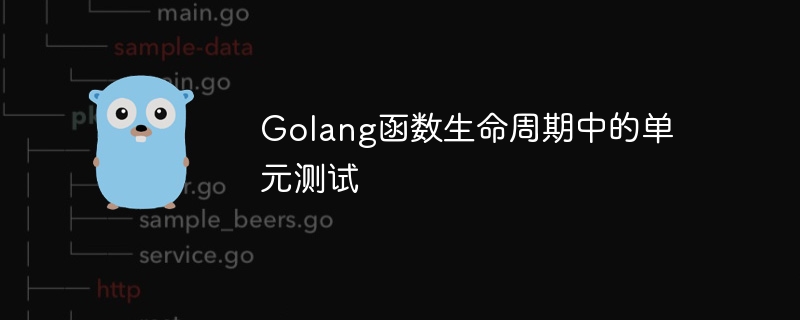
Unit testing is critical to ensure the expected behavior of Golang functions. This article describes strategies for unit testing at different stages of a function's lifecycle: Test initialization and termination: Use runtime.BeforeAlloc and runtime.AfterAlloc to perform setup and cleanup operations before and after memory allocation. Test function signatures: Use the Test function of the testing package to specify test cases against a specific function signature. Test code coverage: Use the -cover flag of the go test command to generate a coverage report to evaluate the test coverage of a function.

Unit testing in Golang function life cycle
Unit testing is important to ensure the expected behavior of Golang functions under different execution paths Crucial. This article will detail strategies for executing unit tests at different stages of a function's life cycle.
Test initialization and termination
In the life cycle of the Golang function, the runtime.BeforeAlloc and runtime.AfterAlloc Function is used to execute specific initialization and termination code before and after memory allocation. These functions can be used to perform test setup and cleanup operations before and after the unit test starts. <div class="code" style="position:relative; padding:0px; margin:0px;"><pre class='brush:go;toolbar:false;'>package main
import (
"fmt"
"runtime"
)
func main() {
runtime.BeforeAlloc() // 执行测试前初始化
// 测试代码
runtime.AfterAlloc() // 执行测试后清理
}</pre><div class="contentsignin">Copy after login</div></div>
testing
The Test function provided by the package can be used to unit test a function. Test Functions specify a specific test case using a test name against the function signature. <div class="code" style="position:relative; padding:0px; margin:0px;"><pre class='brush:go;toolbar:false;'>package main
import (
"testing"
)
func Sum(a, b int) int {
return a + b
}
func TestSum(t *testing.T) {
tests := []struct {
a, b int
want int
}{
{1, 2, 3},
{5, 10, 15},
{-1, 10, 9},
}
for _, test := range tests {
got := Sum(test.a, test.b)
if got != test.want {
t.Errorf("Sum(%d, %d) = %d, want %d", test.a, test.b, got, test.want)
}
}
}
func main() {
testing.Main()
}</pre><div class="contentsignin">Copy after login</div></div>
Unit tests are also used to measure code coverage to ensure that functions have been properly tested. The
go test command can use the -cover flag to generate coverage reports. <div class="code" style="position:relative; padding:0px; margin:0px;"><pre class='brush:shell;toolbar:false;'>go test -cover
coverage:
/path/to/package/func_test.go:62.5% (statements)</pre><div class="contentsignin">Copy after login</div></div>
Testing a simple addition function
Consider a function
Add, It adds two numbers. The following unit test ensures that Add calculates the sum correctly under different inputs: <div class="code" style="position:relative; padding:0px; margin:0px;"><pre class='brush:go;toolbar:false;'>package main
import (
"testing"
)
func Add(a, b int) int {
return a + b
}
func TestAdd(t *testing.T) {
tests := []struct {
a, b int
want int
}{
{1, 2, 3},
{5, 10, 15},
{-1, 10, 9},
}
for _, test := range tests {
got := Add(test.a, test.b)
if got != test.want {
t.Errorf("Add(%d, %d) = %d, want %d", test.a, test.b, got, test.want)
}
}
}</pre><div class="contentsignin">Copy after login</div></div>
Consider a function
InitAndTerminate, which performs some initialization and terminates operations. The following unit test is tested using runtime.BeforeAlloc and runtime.AfterAlloc: <div class="code" style="position:relative; padding:0px; margin:0px;"><pre class='brush:go;toolbar:false;'>package main
import (
"fmt"
"runtime"
"testing"
)
func InitAndTerminate() {
fmt.Println("Initializing...")
runtime.BeforeAlloc() // 执行初始化操作
fmt.Println("Terminating...")
runtime.AfterAlloc() // 执行终止操作
fmt.Println("Terminated.")
}
func TestInitAndTerminate(t *testing.T) {
runtime.BeforeAlloc() // 触发自定义初始化
InitAndTerminate() // 执行被测函数
runtime.AfterAlloc() // 触发自定义终止
}</pre><div class="contentsignin">Copy after login</div></div>
Passed in Golang function Executing unit tests at different stages of the life cycle ensures that the expected behavior of the function is verified under all possible execution paths. The strategies and practical examples discussed in the article provide a comprehensive guide to unit testing in Golang.
The above is the detailed content of Unit testing in Golang function life cycle. For more information, please follow other related articles on the PHP Chinese website!
 How to define variables in golang
How to define variables in golang
 What are the data conversion methods in golang?
What are the data conversion methods in golang?
 What are the commonly used libraries in golang?
What are the commonly used libraries in golang?
 What is the difference between golang and python
What is the difference between golang and python
 Database doubt repair method
Database doubt repair method
 How to use months_between in SQL
How to use months_between in SQL
 The difference between heap and stack
The difference between heap and stack
 How to implement recursive query in mysql
How to implement recursive query in mysql